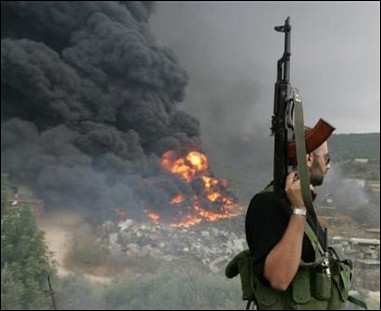

Hezbollah, via Iran and Syria, would most likely be brought to its knees if faced with a direct conventional attack from a country like Israel or the United States. However, out of fear of igniting an all-out scrimmage in the incendiary region, the very scenario that could eradicate Hezbollah is unlikely to take place. Instead, the deeply entrenched terrorist organization will continue to build its irregular warfare capabilities in order to coerce, constrain, and conduct asymmetric maneuvering in an ever-evolving war of attrition. Iran, as Hezbollah’s key sponsor, is especially proficient at waging irregular warfare: it has built up a hybrid of capabilities to defend territory, manipulate neighboring countries, threaten the flow of oil in the Gulf, and attack strategic targets across the Middle East.
Just last week, twin explosions that killed 55 people in Damascus galvanized Bashar Assad’s allies to bolster its weapons activities. Within hours of the event, Tehran ordered its proxy Hezbollah to immediately open up its arms stores and run significant quantities of weapons across the border to support the Syrian army, indicating an unusual reversal of the accustomed flow of arms supplies between the parties. Officials in Washington D.C. quietly requested that Lebanese President Michel Suleiman halt the interaction, but unsurprisingly these calls were ignored.


In a recent statement, Israel’s defense establishment has indicated that it stands ready to take action should Syria’s arsenal of unconventional weapons fall in to Hezbollah’s hands. According to Israeli intelligence, Syria’s massive repository includes surface-to-air missiles, high-trajectory long-range rockets, and biological/chemical weapons – – a substantial supply that could endanger the entire Middle East if it falls into the wrong hands. At the same time, the Fares news agency reported today that Iranian officials had warned Nasrallah not to make any radical moves that might ignite a sudden, large-scale attack from the “Zionist regime”, indicating that the entities are not yet ready to make their grand attack.
However, at this point, it doesn’t seem to be a question of if, but when.
The Pressing Questions: What can we learn from Iran and Hezbollah’s long-term attritive techniques in order to not only defend against them, but to also use these same capabilities to undermine Iran/Hezbollah prowess?
Read more below:
Hizb Allah’s Countertintelligence War by The Combatting Terrorism Center at West Point
The Iran Primer by The Conventional Military
Hizballah Rushes Arms to Syria by Debka
Israel: We Will Act to Prevent Syria’s Chemical Weapons from Reaching Hezbollah by The Telegraph
Iran to Hezbollah: Don’t Strike Israel by Yediot Ahronot
- A Recipe for Leadership: Visions from Jerusalem’s Presidential Conference 2013 - 6/21/2013
- Security on the Ground: A Perspectives Tour - 12/5/2012
- A Carefully Calibrated Attack - 11/15/2012






“The Pressing Questions: What can we learn from Iran and Hezbollah’s long-term attritive techniques in order to not only defend against them, but to also use these same capabilities to undermine Iran/Hezbollah prowess?”
Surely you are not suggesting we fight fire with fire and employ asymmetric tactics in our potential, some would say inevitable, battles against Hezbollah? In the last fight Israel lost a number of tanks to their fleet footed and surprisingly well armed Hezbollah rivals. Taking out a Merkavah is no small thing. And while aerial assaults are easy since Hezbollah has no effective anti-air capabilities, they were not enough to stop the rain of rockets on Israel. At all.
The question then is, what will Israel do differently next time to stop the Hezbollah rockets? Will it be possible to hurt Hezbollah without also hurting the otherwise innocent civilian population of South Lebanon and thus handing Hezbollah a PR victory?
They just look rough… Israel is way more powerful and organized…
Jewish communities